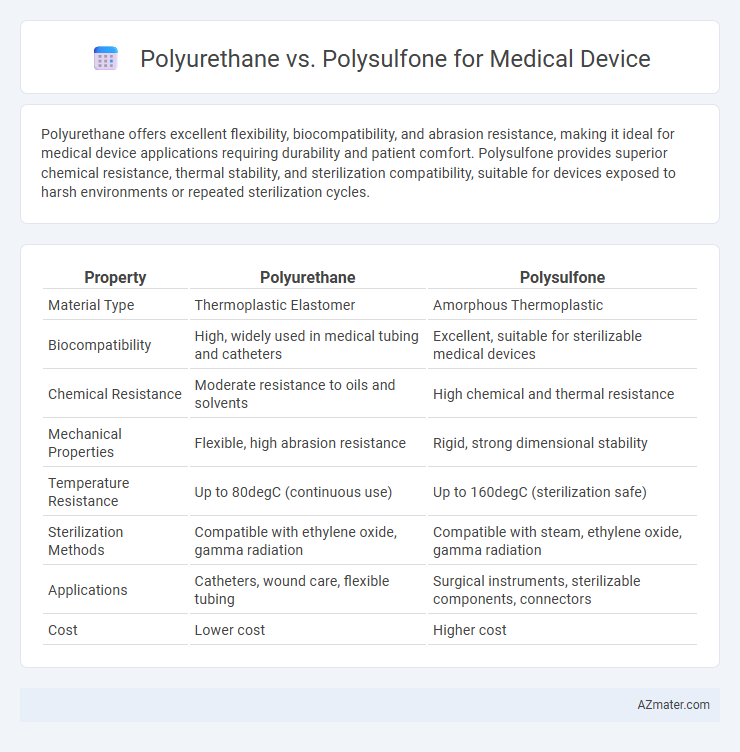Polyurethane offers excellent flexibility, biocompatibility, and abrasion resistance, making it ideal for medical device applications requiring durability and patient comfort. Polysulfone provides superior chemical resistance, thermal stability, and sterilization compatibility, suitable for devices exposed to harsh environments or repeated sterilization cycles.
Table of Comparison
| Property | Polyurethane | Polysulfone |
|---|---|---|
| Material Type | Thermoplastic Elastomer | Amorphous Thermoplastic |
| Biocompatibility | High, widely used in medical tubing and catheters | Excellent, suitable for sterilizable medical devices |
| Chemical Resistance | Moderate resistance to oils and solvents | High chemical and thermal resistance |
| Mechanical Properties | Flexible, high abrasion resistance | Rigid, strong dimensional stability |
| Temperature Resistance | Up to 80degC (continuous use) | Up to 160degC (sterilization safe) |
| Sterilization Methods | Compatible with ethylene oxide, gamma radiation | Compatible with steam, ethylene oxide, gamma radiation |
| Applications | Catheters, wound care, flexible tubing | Surgical instruments, sterilizable components, connectors |
| Cost | Lower cost | Higher cost |
Introduction to Polyurethane and Polysulfone in Medical Devices
Polyurethane and polysulfone are widely used polymers in medical device manufacturing due to their unique properties. Polyurethane offers excellent flexibility, biocompatibility, and abrasion resistance, making it ideal for catheters, tubing, and wound dressings. Polysulfone stands out for its high thermal stability, chemical resistance, and strength, commonly used in sterilizable components like dialyzers and surgical instruments.
Chemical Structure and Properties Comparison
Polyurethane offers high flexibility, excellent abrasion resistance, and biocompatibility due to its segmented block copolymer structure with soft and hard segments derived from diisocyanates and polyols. Polysulfone features a rigid aromatic backbone with sulfone groups, providing superior thermal stability, chemical resistance, and dimensional stability in medical devices. The chemical structure of polyurethane allows for elasticity and cushioning, while polysulfone's structure results in toughness and resistance to hydrolysis and sterilization methods commonly used in medical applications.
Biocompatibility and Safety Profiles
Polyurethane and polysulfone are widely used polymers in medical devices, with polyurethane offering excellent flexibility and biocompatibility for applications requiring soft, elastic materials such as catheters and wound dressings. Polysulfone provides superior thermal stability and chemical resistance, making it suitable for sterilizable devices like hemodialysis membranes and surgical instrument components. While polyurethane shows higher potential for protein adhesion and degradation under oxidative stress, polysulfone's inertness enhances long-term biocompatibility and safety profiles, minimizing inflammatory responses and cytotoxicity risks.
Mechanical Strength and Durability
Polyurethane offers excellent mechanical strength with high abrasion resistance and flexibility, making it ideal for devices requiring repeated movement or bending. Polysulfone features superior thermal stability and long-term durability under harsh sterilization processes, maintaining structural integrity in medical environments. Both materials excel in mechanical strength and durability, but polyurethane suits dynamic applications, while polysulfone provides enhanced resistance to heat and chemical exposure.
Sterilization Resistance and Methods
Polyurethane and polysulfone are widely used in medical devices, with polysulfone offering superior sterilization resistance due to its high thermal and chemical stability, making it compatible with steam autoclaving, ethylene oxide (EtO), and gamma radiation. Polyurethane, while flexible and biocompatible, is more susceptible to degradation under high heat and harsh sterilization methods, often requiring gas sterilization like EtO or low-temperature plasma for device longevity. Selecting the appropriate polymer depends on the device's sterilization needs and required durability, with polysulfone preferred for repeated steam sterilization cycles and polyurethane suitable for single-use or less aggressive sterilization protocols.
Flexibility and Design Versatility
Polyurethane offers exceptional flexibility and elasticity, making it ideal for medical devices requiring intricate designs and dynamic movement. Polysulfone provides superior rigidity and thermal stability, allowing for precise, high-strength components that maintain dimensional integrity under sterilization. The choice between polyurethane and polysulfone depends on the balance between flexibility for patient comfort and design versatility versus structural robustness for durability and sterilization resilience.
Barrier Properties: Chemical and Fluid Resistance
Polyurethane offers excellent flexibility and biocompatibility but has moderate chemical and fluid resistance, making it less ideal for aggressive solvent exposure in medical devices. Polysulfone provides superior barrier properties with high resistance to a wide range of chemicals, including acids, bases, and sterilization fluids, ensuring durability and longevity in harsh medical environments. Selecting polysulfone enhances device reliability where stringent chemical and fluid barrier performance is critical.
Cost-Effectiveness and Manufacturing Considerations
Polyurethane offers cost-effective manufacturing due to its lower raw material expense and ease of processing, making it suitable for high-volume medical device production. Polysulfone, while more expensive, provides superior thermal stability and chemical resistance, justifying its use in high-performance or sterilization-intensive applications despite higher manufacturing costs. The choice between polyurethane and polysulfone balances initial cost savings against long-term durability and compliance requirements in medical device manufacturing.
Common Medical Device Applications
Polyurethane is widely used in medical devices such as catheters, wound dressings, and surgical tubing due to its excellent flexibility, biocompatibility, and resistance to abrasion. Polysulfone is favored for applications requiring high thermal stability and chemical resistance, including sterilizable components like kidney dialysis membranes and orthopedic device housings. Both materials are critical in medical device manufacturing, with polyurethane typically chosen for soft, flexible parts and polysulfone for rigid, sterilizable components.
Decision Factors: Choosing Between Polyurethane and Polysulfone
Selecting between polyurethane and polysulfone for medical devices depends primarily on biocompatibility requirements, mechanical strength, and sterilization methods. Polyurethane offers superior flexibility and abrasion resistance, making it ideal for catheters and tubing, while polysulfone excels in chemical resistance and thermal stability, suitable for components exposed to repeated sterilization cycles. Cost considerations and regulatory compliance also influence material choice, with polysulfone often preferred for reusable devices and polyurethane favored for single-use applications.

Infographic: Polyurethane vs Polysulfone for Medical device
 azmater.com
azmater.com